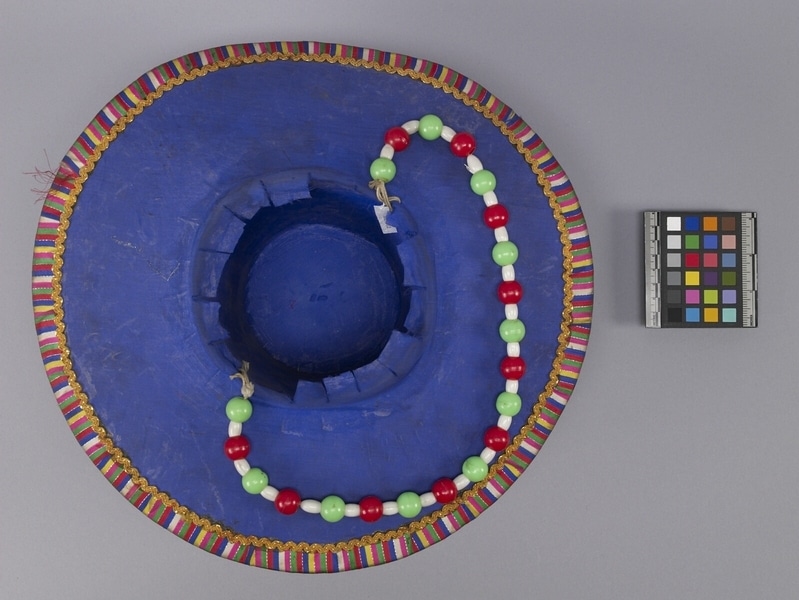Shaman's Hat Item Number: Ed1.282 from the MOA: University of British Columbia



Description
Stiff hat with round brim and straight-sided crown narrowing to a flat top. Hat is solid blue nylon fabric inside and red wool slightly ribbed fabric outside. It has bands of rainbow striped fabric around the edge or brim, base of crown, top of crown, and up each side. The bands are outlined with woven undulating gold ribbon. Metallic sequins in floral and leaf shapes in green, silver, and gold are adhered to the surface. Long string attached underneath on both sides, on which are strung red, green, and white plastic beads. Small red cardboard cylinder on one side of base of crown.
History Of Use
The red hat is worn during incantations to assist in contacting spirits and gods. Such hats are worn primarily by female shamans, but sometimes also by male shamans. The hats may be red, blue, or black; each has a different meaning. The black is of higher rank. Such hats resemble those worn by military officials, and the shamans who wear them can expel the ghosts of generals. They are decorated with shiny ornaments to impress the onlookers. Such hats should include peacock feathers or tiger whiskers (real or imitation) stuck into the small cylinders at each side. When performing exorcisms, the shaman would carry a sword and a spear. With the hat they sometimes wore a costume like that of a king or queen. To expel ghosts, they had to have extraordinary powers, as did kings, queens, generals, and officials. Many different kinds of costumes are used, representing different regions, periods, and styles. There are many stages in a full ceremony (“gut”), and the shaman may change costumes many times accordingly. She might wear a skirt (“chima”) on her head, then a hat then armour, then court dress, in any order.
Cultural Context
shamanism; ritual; exorcism
Item History
- Made in Seoul, Korea
- Owned by Hi Soon Kim before June 21, 1983
- Received from Hi Soon Kim (Seller) and Museum of Anthropology Shop Volunteers (Funding source) on June 21, 1983
What
- Name
- Shaman's Hat
- Identification Number
- Ed1.282
- Type of Item
- hat
- Material
- paste adhesive, wool fibre, nylon fibre, paper, silk fibre ?, metal, cotton fibre and plastic
- Manufacturing Technique
- spun, woven, dyed, cut and pasted
- Overall
- height 14.5 cm, diameter 34.5 cm
Who
- Culture
- Korean
- Previous Owner
- Hi Soon Kim
- Received from
- Hi Soon Kim (Seller) and Museum of Anthropology Shop Volunteers (Funding source)
Where
- Holding Institution
- MOA: University of British Columbia
- Made in
- Seoul, Korea
When
- Ownership Date
- before June 21, 1983
- Acquisition Date
- on June 21, 1983
Other
- Item Classes
- textiles
- Condition
- fair
- Accession Number
- 0894/0001